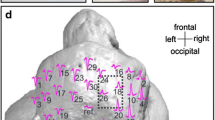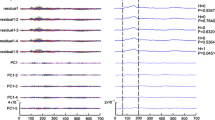Abstract
Brain electrical source analysis (BESA) of the scalp electroencephalographic activity is well adapted to distinguish neighbouring cerebral generators precisely. Therefore, we performed dipolar source modelling in scalp medium nerve somatosensory evoked potentials (SEPs) recorded at 1.5-Hz stimulation rate, where all the early components should be identifiable. We built a four-dipole model, which was issued from the grand average, and applied it also to recordings from single individuals. Our model included a dipole at the base of the skull and three other perirolandic dipoles. The first of the latter dipoles was tangentially oriented and was active at the same latencies as the N20/P20 potential and, with opposite polarity, the P24/N24 response. The second perirolandic dipole showed an initial peak of activity slightly earlier than that of the N20/P20 dipolar source and, later, it was active at the same latency as the central P22 potential. Lastly, the third perirolandic dipole exaplaining the fronto-central N30 potential scalp distribution was constantly more posterior than the first one. In order to evaluate the effect of an increasing repetition frequency on the activity of SEP dipolar sources, we applied the model built from 1.5-Hz SEPs to traces recorded at 3-Hz and 10-Hz repetition rates. We found that the 10-Hz stimulus frequency reduced selectively the later of the two activity phases of the first perirolandic dipole. The decrement in strength of this dipolar source can be explained if we assume that: (a) the later activity of the first perirolandic dipole can represent the inhibitory phase of a “primary response”; (b) two different clusters of cells generate the opposite activities of the tangential perirolandic dipole. An additional finding in our model was that two different perirolandic dipoles contribute to the centro-parietal N20 potential generation.
Similar content being viewed by others
Author information
Authors and Affiliations
Additional information
Received: 5 August 1997 / Accepted: 26 November 1997
Rights and permissions
About this article
Cite this article
Valeriani, M., Restuccia, D., Di Lazzaro, V. et al. Dipolar sources of the early scalp somatosensory evoked potentials to upper limb stimulation Effect of increasing stimulus rates. Exp Brain Res 120, 306–315 (1998). https://doi.org/10.1007/s002210050404
Issue Date:
DOI: https://doi.org/10.1007/s002210050404




